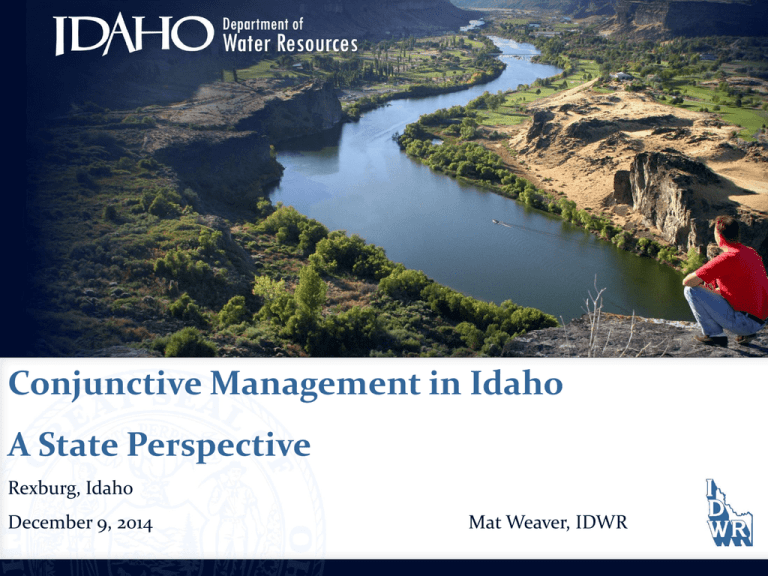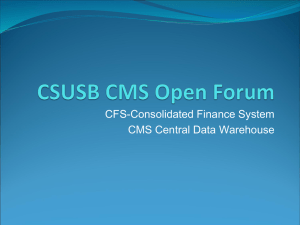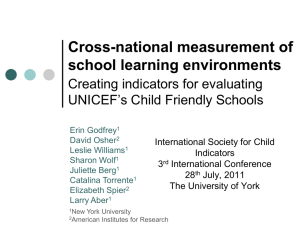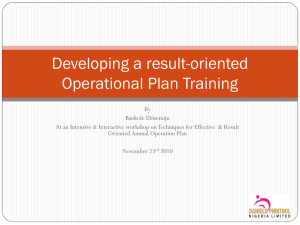Mat Weaver
advertisement

Conjunctive Management in Idaho A State Perspective Rexburg, Idaho December 9, 2014 Mat Weaver, IDWR Prior Appropriation Water is a public resource that can be appropriated by private parties “First in time is first in right” (seniority) Diversion and application to beneficial use Elements of Water Right Source Priority Date Rate of Diversion Beneficial Use Season of Use Point of Diversion Place of Use Elements of a Water Right Priority Date Determines who gets water in shortage Date Water Right Established Relates back to date of filing if right based on application/permit process May relate back to date of first use if based on statutory or beneficial use claim Regulation of Rights by Priority Date Ex. 1: Stream flow = 12 cfs Ex. 2: Stream Flow = 10 cfs Ex. 3: Stream Flow = 7 cfs B Ex. 4: Stream Flow = 5 cfs A Irr. 5 cfs, 1880 Ex. 1-4: 5 cfs Irr. 5 cfs, 1885 Ex. 1: Ex. 2: Ex. 3: Ex. 4: 5 cfs 5 cfs 2 cfs 0 cfs Irr. 2 cfs, 1905 Ex. 1: 2 cfs Ex. 2-4: 0 cfs Regulation of Rights by Priority Date Stream flow = 5 cfs Ex. 5: Pre-1973 watermaster records show stream flow rarely less than 8 to 10 cfs and 1885 right normally not cut or cut nor more than 3 cfs. Well 1973 Priority Rt. B A Watermaster records over past 20 years show 1885 right cut entirely in most years during mid to late season. Irr. 5 cfs, 1880 Irr. 5 cfs, 1885 Irr. 2 cfs, 1905 Can User B call for delivery of water against owner of ground water right ? Does ground water pumping cause injury to water rights diverted from the stream? Idaho has a process to address this question! Conjunctive Management of Surface and Ground Water Resources Conjunctive Management Rules IDAPA 37.03.11 Authorized by I.C. § 42-603 IDWR Adopted 1994 (approved by Legislature 1995) Conjunctive Management Rules Definitions Filing delivery calls Responding to delivery calls Determination of Material Injury Mitigation Plans Conjunctive Management Rules…Definitions Conjunctive Management Defined (010.03): - Legal and hydrologic integration of administration of the diversion and use of water under water rights from surface and ground water sources, including areas having a common ground water supply. Or, Administration of surface water and ground water rights together from a common source Conjunctive Management Rules…Definitions Material Injury defined (020.01): “Hindrance to or impact upon the exercise of a water right caused by another person as determined in accordance with Idaho Law, as set forth in Rule 42.” Conjunctive Management Rules…Filing & Responding to Delivery Calls Delivery Calls within unregulated areas (030) Delivery calls within organized Water Districts (040) Delivery calls within Ground Water Management Areas (041) Conjunctive Management Rules…Determining Material Injury Rule 42.01 – Factors in Determining Material Injury include but are not limited to: • • • • • • • Amount of water available to the senior Expense to divert water from the source by the senior Whether Jr.’s affect quantity and timing of water availability Amount of water used and diverted by the senior Existence of water measurement and recording devices Whether the senior’s needs can be met w/ existing water supply Reasonableness of the senior’s diversions and activities Conjunctive Management Rules…Mitigation Rule 42.02 – Mitigation ‘Holder of a senior priority right will be prevented from making delivery call for curtailment of pumping of any well used by the holder of a junior priority ground water right if junior right is covered by an approved and effectively operating mitigation plan.’ Mitigation Plans can be phased in over period of 5 years - Various factors considered for acceptable plans per rules Mitigation may allow juniors to pump out of priority even if material injury determined Delivery Calls and Mitigation in a Water District (process/timeframe) Senior must submit petition alleging injury by junior users and identify senior rights being injured Initial investigation by Water District watermaster and IDWR Director may request additional information from Senior (senior does not bear burden to determine/prove injury) Delivery Calls and Mitigation in a Water District (process/timeframe) IDWR Director considers factors to determine material injury Matter generally handled as contested case as per IDAPA Rules Pre-hearing schedule - information gathered/provided by both senior and junior right holders; expert reports/analyses; motions; depositions; etc. Hearing scheduled and held Delivery Calls and Mitigation in a Water District (process/timeframe) Time from Delivery Call Petition to Hearing May take up to one year or more: May depend on complexity of case and parties May depend on availability of ground water model or other analytical tools Post Hearing Director review and consideration May require use of ground water model Injury determination does not require model but model may be necessary to determine extent of injury & complete order Delivery Calls and Mitigation in a Water District (process/timeframe) From Call to Post Hearing Parties may discuss settlement If Director Finds Material Injury Curtailment Ordered with priority date identified Mitigation requirements identified with ability to phase in over five years Watermaster(s) notify juniors of curtailment Delivery Calls and Mitigation in a Water District (process/timeframe) Mitigation Plans Plans must be advertised Hearing(s) scheduled Director Orders issued Ground Water Districts An organizational opportunity in which junior ground water users can collectively be represented - Address delivery calls - Formulate mitigation plans - Other benefits? Ground Water Districts Features Similar to Irrigation Districts in method of creation and organization Participation is voluntary (include/exclude) Users can join districts as full members or for mitigation purposes only Board of Directors with fairly broad powers Levy assessments Water Districts Organization created for purposes of water right administration, specifically, distribution of water from public or natural water sources - Conduct water measurements - Annual report water diversion - Administer water by prior appropriation - Enforce delivery calls - Curtail water use Conjunctive Administration…Tensions in the Process Timing of the impacts Distance between the senior and the junior What does it mean to be futile Conjunctive Administration…Tensions in the Process General Statements…Delivery Calls (020.04) “The principle of the futile call applies to the distribution of water under these rules. Although a call may be denied under the futile call doctrine, these rules may require mitigation or staged or phased curtailment of a junior-priority use if diversion and use of water by the holder of the junior-priority water right causes material injury, even though not immediately measurable, to the holder of a seniorpriority surface or ground water right in instances where the hydrologic connection may be remote, the resource is large and no direct immediate relief would be achieved if the junior-priority water use was discontinued.” Questions and Discussion? Regulation of Rights by Priority Date Ex. 5: Stream flow at B = 10 cfs, but there is 1 cfs reach loss between points B & A. B A Irr. 5 cfs, 1880 Irr. 5 cfs, 1885 Ex. 5: 4 cfs Ex. 5: 5 cfs Conjunctive Management Rules…Applicability “These rules apply where diversion and use of water under junior priority ground water rights either individually or collectively causes material injury to use of water under senior priority water rights” (020.01) “These rules provide the basis and procedure for responding to delivery calls by the holder of a senior priority surface or ground water right against the holder of junior priority ground water right.” (020.04) Ground Water Districts Chapter 52, Title 42, Idaho Code Created by county commission upon petition of land owners holding ground water irrigation rights & those right holders voting to create district. Created for purpose of organizing ground water irrigation users. (Legislation effective 1995. Nine districts created and currently active.) Ground Water Districts Features Authority of Board (IC § 42-5224) - represent members in various water related matters/issues - develop and maintain mitigation plans - conduct recharge/construct recharge facilities - acquire property and water rights - measure and report water use - levy assessments for operation of district - enter into contracts and agreements Ground Water Districts Features Annual Assessments - collected directly or via county tax rolls - can make liens against property - based on pro-rata charge against water right diversion rates (some districts use irrigated acreage as basis)










